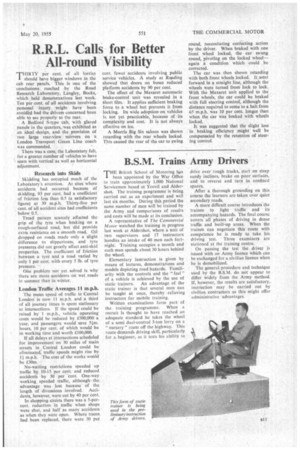B.S.M. Trains Army Drivers
Page 37

If you've noticed an error in this article please click here to report it so we can fix it.
'THE British School of Motoring has I been appointed by the War Office to train approximately 1,000 National Servicemen based at Yeovil and Aldershot. The training programme is being carried out as an experiment and will last six months. During this period the same number of men will be trained by the Army and comparisons of results and costs will be made at us conclusion.
A representative of The Commercial Motor watched the training in progress last week at Aldershot, where a unit of two supervisors and 17 instructors handles an intake of 40 men each fortnight. Training occupies a month and each man spends about 30 hours behind the wheel.
Elementary instruction is given by means of lectures, demonstrations and models depicting road hazards. Familiarity with the controls and the " feel " of a vehicle is achieved by the use of static trainers. An advantage of the static trainer is that several men can be taught at once, thereby relieving instructors for mobile training.
Written examinations form part of the. training programme. When a recruit is thought to have reached an adequate standard he takes the wheel of a semi dual-control 3-ton lorry on a " nursery" route off the highway. This route demands driving skill, particularly for a beginner, as it tests his ability to drive over rough tracks, start on steep sandy inclines, brake on poor surfaces. and to reverse and turn in confined spaces.
After a thorough grounding on this course the learners are taken over quiet secondary roads.
A more difficult course introduces the trainee to light traffic and its accompanying hazards. The final course covers all phases of driving in dense traffic and built-up areas. When the trainee can negotiate this route with competence he is ready to take his driving test. Three examiners are stationed at the training centre.
On passing the test the driver is issued with an Army licence which can be exchanged for a civilian licence when he is demobilized.
The general, procedure and technique used by the B.S.M. do not appear to differ widely from the Army method. If, however, the results are satisfactory, instruction may be carried out by civilian contractors as this might offer administrative advantages.




















































































